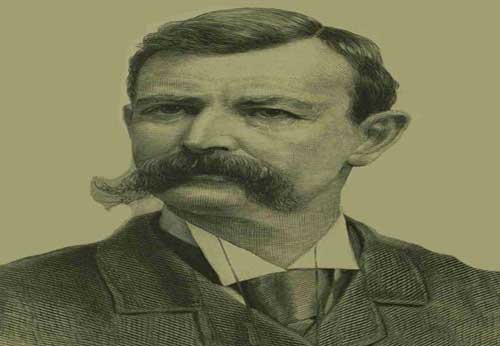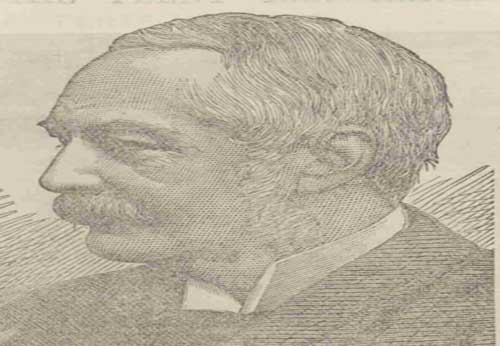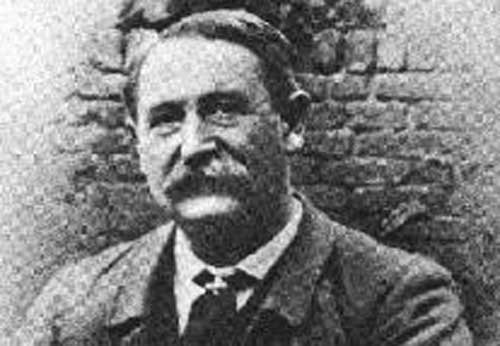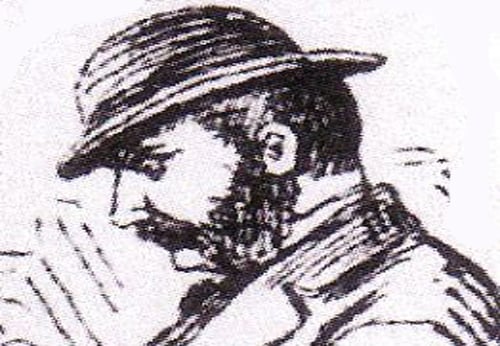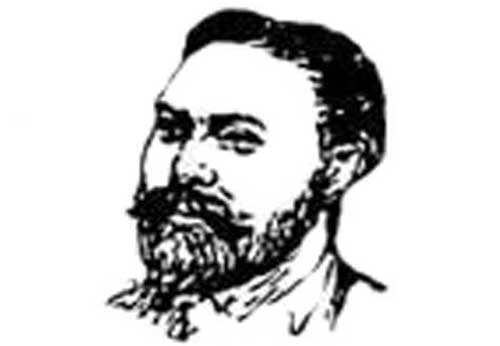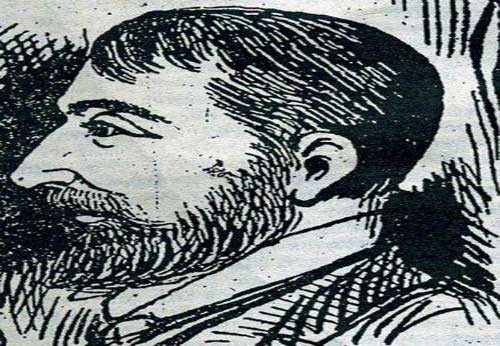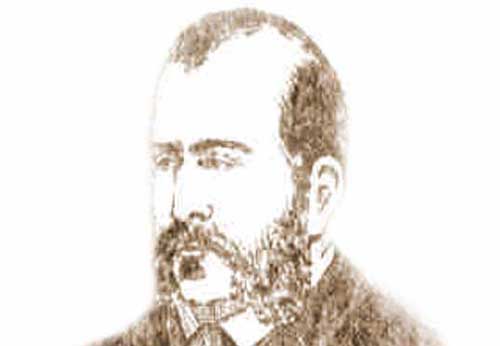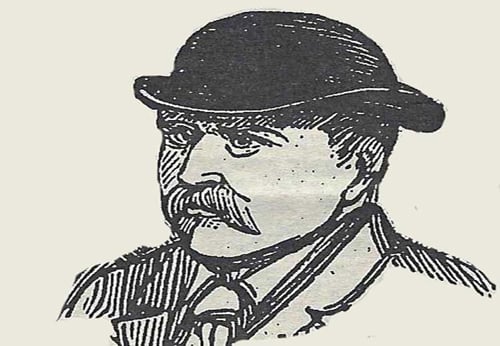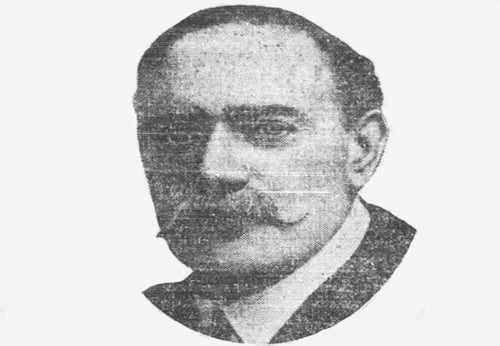- Chief Inspector Donald Swanson was the officer who had the ultimate direct charge of the investigation into the crimes between September 7th and 6th October, 1888.
- He then remained the desk officer, working under Dr. Robert Anderson, until the end of the case.
- As the officer tasked with reading, assessing and collating all the information coming in on the case he acquired an unrivalled knowledge of the case..
- Site Author and Publisher Richard Jones
- Richard Jones
DONALD SUTHERLAND SWANSON
THE MAN WITH THE BIG PICTURE
Chief Inspector Donald Sutherland Swanson (1848 - 1924) was the man who was placed in overall charge of the Whitechapel murders police investigation on the 7th of September 1888.
He would remain at the helm of the investigation until the 6th of October, 1888, when Assistant Commissioner, Dr. Robert Anderson, returned from sick leave.
Thereafter, Swanson became the second most senior officer with direct responsibility for the case, and was the policeman who was given the job of assessing all the information that the Jack the Ripper investigation was yielding, and, in so doing, he built up an unrivalled knowledge of the case, being the one man who had access to every strand of data on the case.
ONE MAN TO BE PUT IN CHARGE
It was, in fact, the Chief Commissioner of the Metropolitan Police, Sir Charles Warren, who gave Swanson the task of collating all the facts on the case.
Warren himself was actually away on holiday during the first week of September - the week that saw the launch of the investigation into the murder of Mary Nichols - and he returned on the 7th September, 1888, the day before Annie Chapman was murdered.
Once back he evidently realised that, if the hunt for the killer was to be successful, one man had to take over all charge of the investigation.
WARREN'S EYES AND EARS
On 15th September, 1888, Warren dictated the following memo to the Home Office, in which he stated his wish to give Chiech Inspector Swanson total responisiblity for collating the all information on the case:-
I am convinced that the Whitechapel Murder case is one which can be successfully grappled with if it is systematically taken in hand. I go so far as to say that I could myself in a few days unravel the mystery provided I could spare the time & give individual attention to it.
I feel therefore the utmost importance to be attached to putting the whole Central Office work in this case in the hands of one man who will have nothing else to concern himself with.
Neither you or I or Mr. Williamson can do this, I therefore put it in the hands of Chief Inspector Swanson who must be acquainted with every detail.
I look upon him for the time being as the eyes & ears of the Commissioner in this particular case.
He must have a room to himself, & every paper, every document, every report every telegram must pass through his hands. He must be consulted on every subject. I would not send any directions anywhere on the subject of the murder without consulting him.
I give him the whole responsibility...All the papers in Central Office on the subject of the murder must be kept in his room & plans of the positions etc.
I must have this matter at once put on a proper footing so as to be a guide for the future in cases of importance.
SWANSON OF THE YARD
As the officer over whose desk virtually every snippet of fact, speculation and theory would have passed, Chief Inspector Swanson was the man who had the "big picture" on the crimes; but given his desk-based role, he appears not to have attracted the notice of many of the newspapers and the comparatively few mentions of him in the press, at least with regard to the ripper crimes, bely what was, in fact, a massive contribution to the case.
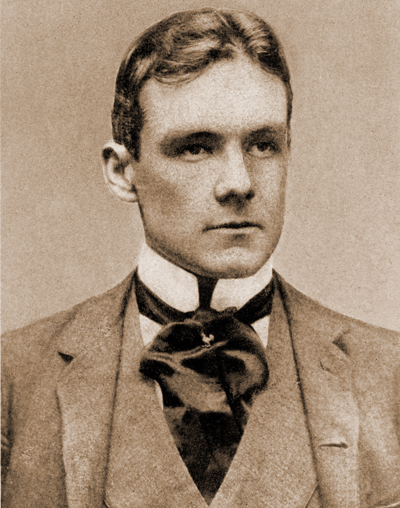
Richard Harding Davis
(1864-1916)

Dr Robert Anderson
(1841 - 1918)
REPORTS ON THE MURDERS
From early September Swanson set about acquainting himself with the known facts and the results of police enquires on the murders of Martha Tabram and Mary Nichols, and Annie Chapman, collating them into three reports which he submitted to his superiors, in early September, and on October 19th, 1888.
ELIZABETH STRIDE'S MURDER
Chief Inspector Swanson's name was featured in several newspaper reports that were published in the wake of the murder of Elizabeth Stride on 30th September, 1888.
The St James's Gazette, for example, published the following brief mention of his involvement in its edition of 1st October, 1888:-
...Intelligence of the murder was telegraphed to Scotland Yard, and the case was placed in the hands of Chief Inspector Swanson and Inspector Abberline, the latter having formerly being stationed in the H Division..."
THE MURDER OF CATHERINE EDDOWES
Forty five minutes fater the body of Elizabteh Stride had been found in berner Street the Ripper struck again and murdered Catherine Eddowes in Mitre Square.
the fact that Mitre Square wss in the City of London meant that a second police force, the City of London Police, now became officially involved in the hunt for the Whitechapel murderer.
Chief Inspector Swanson then became the liasion officer betwen the two forces, and he, therore, consulted with Inspector James McWilliam of the City of London Police on a daily basis.
As a consequence, he also became au fait with what was known on the Catherine Eddowes murder investigation.
THE POLICE ACTIVITY
Swanson compiled an extremely detailed report on the murder of Elizabeth Stride, and concluded by giving details of the measures the police had undertaken in their endeavours to bring the perpetrator to justice-
...80,000 pamphlets to occupier were issued and a house to house enquiry made not only involving the result of enquiries from the occupiers but also a search by police & with a few exceptions - but not such as to convey suspicion - covered the area bounded by the City Police boundary on the one hand, Lamb St. Commercial St. Great Eastern Railway & Buxton St. then by Albert St. Dunk St. Chicksand St. & Great Garden St to Whitechapel Rd. and then to the City boundary, under this head also Common Lodging Houses were visited & over 2000 lodgers were examined.
Enquiry was also made by Thames Police as to sailors on board ships in Docks or river & extended enquiry as to asiatics present in London, about 80 persons have been detained at the different police stations in the Metropolis & their statements taken and verified by police & enquiry has been made into the movements of a number of persons estimated at upwards of 300 respecting whom communications were received by police & such enquiries are being continued.
Seventy six Butchers & Slaughterers have been visited & the characters of the men employed enquired into, this embraces all servants who had been employed for the past six months.
Enquiries have also been made as to the alleged presence in London of Greek Gipsies, but it was found that they had not been in London during the times of the previous murders.
Three of the persons calling themselves "Cowboys" who belonged to the American Exhibition were traced & satisfactorily accounted for themselves.
Up to date although the number of letters daily is considerably lessened, the other enquiries respecting alleged suspicious persons continues as numerous.
There are now 994 Dockets besides police reports.
Donald S. Swanson
Ch. Inspr."
THE MURDER OF FRANCES COLES
The final Whitechapel murders victim was Frances Coles, whose body was found by Police Constable Ernest Thompson in Swallow Gardens, a railway arch just off Royal Mint Street, close to the Tower of London, in the early hours of the 13th February, 1891.
The Cardiff Times reported on Swanson's involvement with the case in its edition of Saturday, 14th February, 1891:-
Shortly after 7 o'clock, Chief Inspector Swanson, of Scotland Yard, arrived, and with Inspector Arnold [sic] made a searching examination of the spot, and the walls and boarding surrounding it. No marks of any kind were, however, found.
A portion of blood in the roadway was, by the direction of Mr. Swanson, collected and preserved for analysis.
the archway was then opened for traffic.
Mr. Swanson has been charged with further investigation of the crime..."
DID HE HAVE AN OPINION?
Of course, given his involvement with so many facets of the case, Swanson's opinion on who the perpetrator of the Jack the Ripper crimes might have been would carry an awful lot of weight.
However, Swanson was extremely tight-lipped about any personal theories he may have held and, according to an article in the Police Review, published on 15th May, 1896, he viewed "his work as decidedly secret service" and was "opposed to public "reminiscences"..."
Consequently, he is one of the few officers who never made any public comment on his involvement in the case, and what we know of his thoughts on the matter, comes from what others said about him.
For example, on the 7th May, 1895, The Pall Mall Gazette began an article with the following tantalising paragraph:-
Since the cessation of the Whitechapel murders there has been no lack of theories accounting for the disappearance of the author of those crimes, "Jack the Ripper", as he is called, in consequence of a series of letters so signed, purporting, rightly or wrongly, to come from the murderer.
The theory entitled to the most respect, because it was presumably based upon the best knowledge, was that of Chief Inspector Swanson, the officer who was associated with the investigation of all the murders, and Mr. Swanson believed the crimes to be the work of a man who is now dead..."
THE SWANSON MARGINALIA
Owing to his close friendship with Robert Anderson, Swanson received a copy of his former boss's autobiography The Lighter Side of My Official Life, when it was published in 1910.
In the pages of the book Anderson made the following claim:-
...undiscovered murders are rare in London, and the "Jack-the-Ripper" crimes are not in that category...I will merely add that the only person who had ever had a good view of the murderer unhesitatingly identified the suspect the instant he was confronted with him; but he refused to give evidence against him...In saying that he was a Polish Jew I am merely stating a definitely ascertained fact..."
KOSMINSKI WAS THE SUSPECT
Anderson stopped short of either naming the suspect, or of giving a reason why the "witness refused to give evidence against him."
However, Swanson, reading the memoirs in his retirement, decided to add some penciled notes to the margin of the book, and, in so doing, revealed what he knew about Anderson's unnamed suspect.
As to why the witness wouldn't give evidence, Swanson wrote, "...Because the suspect was also a Jew ...and witness would be the means of murderer being hanged which he did not wish to be left on his mind..."
And then Swanson goes on to reveal what became of the suspect:-
...the suspect, with his hands tied behind his back...was sent to Stepney Workhouse and then to Colney Hatch [lunatic asylum] - Kosminski was the suspect."
Article Sources
Register of Leavers From The Metropolitan Police. Ref: MEPO 4/342/70
St James's Gazette, 1st October, 1888.
The Cardiff Times, Satutday, 14th February, 1891.
The Pall Mall Gazette, 7th May, 1895.
The Police Review, 15th May, 1896.
Paul Begg, Martin Fido and Keith Skinner. The Jack the Ripper A to Z. Headline Book Publishing Plc (1992)
Richard Jones. Uncovering Jack The Ripper's London. New Holland Publishing (2007)

